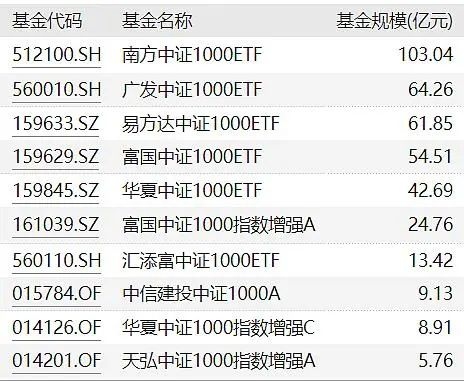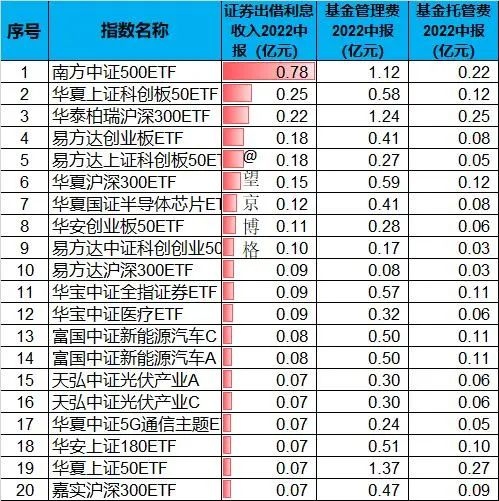1. “Coupon sources” are more attractive than commissions

The CSI 1000 ETF battle has been going on for two months. Wangjing Boge checked the scale of the CSI 1000 products tracked as of September 30:
The only one in the south that exceeds 10 billion yuan, GF, E Fund, and Fuguo are all around 6 billion yuan. Huaxia has also slowly increased to 4.2 billion, and the scale of low-cost Huitianfu has dropped to around 1.3 billion.
I also specifically asked my friends in the industry: “If you pay commissions for scale, GF, E Fund, and Fuguo are not bad for commissions. Why is the southern region the largest?”
People answered: ” Coupon sources are more attractive than commissions .”
What is a “coupon source”?
In the margin financing and securities lending business, “financing” is easy to understand. It is borrowing money from securities companies to speculate in stocks, and borrowing money according to the rules needs to pay interest; “short selling” corresponds to “financing”, which is to borrow stocks from securities companies (short selling to make money) , the same “bond lending” also need to pay interest.
A customer “lends securities” to a stock, such as China Merchants Bank, and the securities company needs to have China Merchants Bank stock to lend it to you. If the securities company does not, the securities company can borrow China Merchants Bank stocks from index funds (including ETFs) through “refinancing”, and then lend them to customers. In this process, the securities company is an intermediary (earning interest margin income and commission income) .
The interest rate at which index funds (including ETFs) lend their stocks to brokerages is similar, so at this time, it is the fund company who has the final say. For example, which securities firm sells more products, it will lend its ETF holdings to which brokerage firm.
2. Interest income from securities lending
Index funds (including ETFs) also have interest income when they lend out the stocks they hold. The professional term is called “interest income from securities lending”. This interest income is attributed to the fund’s assets, in other words, to the fund holder.
There is this data in the fund’s semi-annual report and annual report. Borg specially organizes it here:

(1) According to the 2022 interim report, the interest income from securities lending of the Southern 500 ETF is 78 million yuan, the highest income among all index funds; the total management fee and custody fee of the Southern 500 ETF in 2022 is 134 million yuan, and the interest income is basically These two payments can be deducted by half, and it is a good thing for investors if they are all deducted.
(2) The scale of the Southern 500ETF is similar to that of the Huatai-Pineapple 300ETF. The Huatai-Pineapple 300ETF received a management fee of 124 million yuan in the first half of the year, and the Southern 500ETF received a management fee of 112 million yuan in the first half of the year, but compared with the Southern 500ETF’s 78 million yuan in securities lending interest In terms of income, the interest income from securities lending of Huatai-Pineapple 300ETF is only 22 million yuan, indicating that the market lacks the securities sources of the CSI 500 constituent stocks, and there is no shortage of securities sources for the CSI 300 constituent stocks. In addition, the interest income from securities lending of the largest Huaxia 50ETF is only 7 million yuan, which shows that investors prefer to finance small and medium-sized securities, and so on.
3. ETFs with zero actual rates
Then, with so many index funds (including ETFs) in the market, is there any ETF whose interest income from securities lending is greater than [management fee + custody fee] and the actual rate is zero?
Borg crunched the data:

It turns out that there are really ETFs with zero real expense ratios.
For example, in the Harvest CSI 500ETF, the interest income from securities lending is 5 million, minus the management fee of 2 million and the custody fee of 1 million, leaving a surplus of 1.7 million.
Among the five ETFs with zero actual rate, except one from Harvest, the other four are from E Fund. These funds have the same feature (using management fee of 0.15%, custody fee of 0.05%) and low fee rate. ETFs.
(End) @Today’s topic @雪ball fund @爱FAT not fat @snowball creator center
This topic has 11 discussions in Snowball, click to view.
Snowball is an investor’s social network, and smart investors are here.
Click to download Snowball mobile client http://xueqiu.com/xz ]]>
This article is reproduced from: http://xueqiu.com/4579887327/232221524
This site is for inclusion only, and the copyright belongs to the original author.